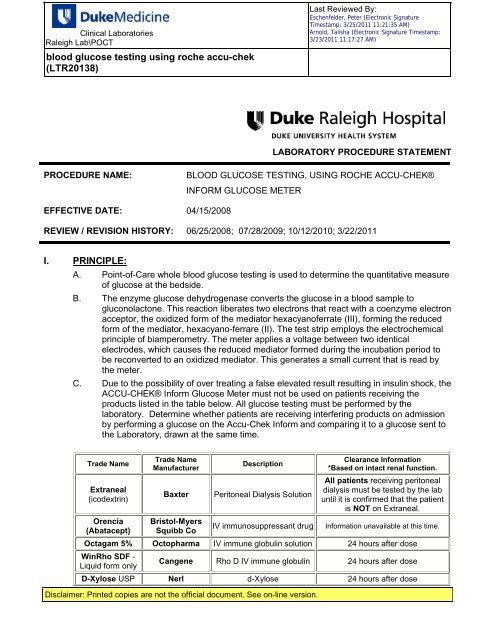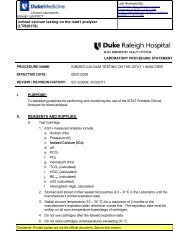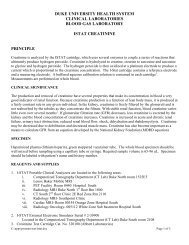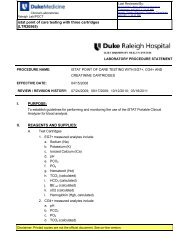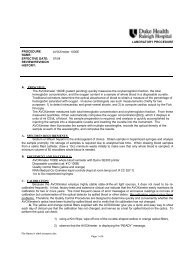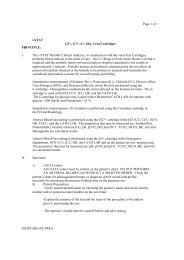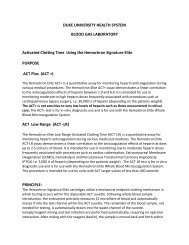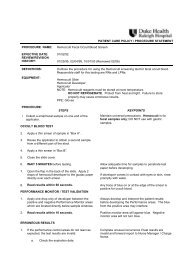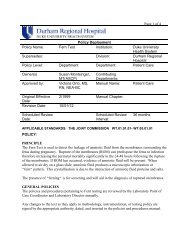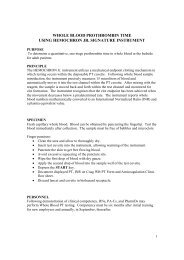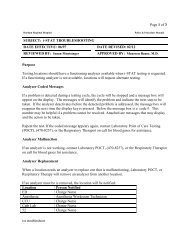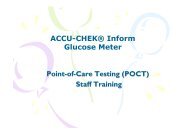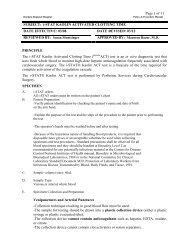blood glucose testing using roche accu-chek - Point of Care Testing
blood glucose testing using roche accu-chek - Point of Care Testing
blood glucose testing using roche accu-chek - Point of Care Testing
Create successful ePaper yourself
Turn your PDF publications into a flip-book with our unique Google optimized e-Paper software.
Clinical LaboratoriesRaleigh Lab\POCT<strong>blood</strong> <strong>glucose</strong> <strong>testing</strong> <strong>using</strong> <strong>roche</strong> <strong>accu</strong>-<strong>chek</strong>(LTR20138)Last Reviewed By:Eschenfelder, Peter (Electronic SignatureTimestamp: 3/25/2011 11:21:35 AM)Arnold, Talisha (Electronic Signature Timestamp:3/23/2011 11:17:27 AM)LABORATORY PROCEDURE STATEMENTPROCEDURE NAME:EFFECTIVE DATE:REVIEW / REVISION HISTORY:BLOOD GLUCOSE TESTING, USING ROCHE ACCU-CHEK®INFORM GLUCOSE METER04/15/200806/25/2008; 07/28/2009; 10/12/2010; 3/22/2011I. PRINCIPLE:A. <strong>Point</strong>-<strong>of</strong>-<strong>Care</strong> whole <strong>blood</strong> <strong>glucose</strong> <strong>testing</strong> is used to determine the quantitative measure<strong>of</strong> <strong>glucose</strong> at the bedside.B. The enzyme <strong>glucose</strong> dehydrogenase converts the <strong>glucose</strong> in a <strong>blood</strong> sample togluconolactone. This reaction liberates two electrons that react with a coenzyme electronacceptor, the oxidized form <strong>of</strong> the mediator hexacyan<strong>of</strong>errate (III), forming the reducedform <strong>of</strong> the mediator, hexacyano-ferrare (II). The test strip employs the elect<strong>roche</strong>micalprinciple <strong>of</strong> biamperometry. The meter applies a voltage between two identicalelectrodes, which causes the reduced mediator formed during the incubation period tobe reconverted to an oxidized mediator. This generates a small current that is read bythe meter.C. Due to the possibility <strong>of</strong> over treating a false elevated result resulting in insulin shock, theACCU-CHEK® Inform Glucose Meter must not be used on patients receiving theproducts listed in the table below. All <strong>glucose</strong> <strong>testing</strong> must be performed by thelaboratory. Determine whether patients are receiving interfering products on admissionby performing a <strong>glucose</strong> on the Accu-Chek Inform and comparing it to a <strong>glucose</strong> sent tothe Laboratory, drawn at the same time.Trade NameExtraneal(icodextrin)Orencia(Abatacept)Trade NameManufacturerBaxterBristol-MyersSquibb CoDescriptionPeritoneal Dialysis SolutionIV immunosuppressant drugDisclaimer: Printed copies are not the <strong>of</strong>ficial document. See on-line version.Clearance Information*Based on intact renal function.All patients receiving peritonealdialysis must be tested by the labuntil it is confirmed that the patientis NOT on Extraneal.Information unavailable at this time.Octagam 5% Octopharma IV immune globulin solution 24 hours after doseWinRho SDF -Liquid form onlyCangene Rho D IV immune globulin 24 hours after doseD-Xylose USP Nerl d-Xylose 24 hours after dose
lood <strong>glucose</strong> <strong>testing</strong> <strong>using</strong> <strong>roche</strong> <strong>accu</strong>-<strong>chek</strong>(LTR20138)Last Review Date: 3/25/2011 11:21:35 AMTrade NameADEPT(4% Icodextrin)VacciniaImmune Globulin(HumanHepaGam BTrade NameManufacturerDiagnostics,othersInnovata PLCDescriptionA fluid used during or afterlaparoscopic GYN surgeryto separate and protecttissues and decreaseadhesions.Clearance Information*Based on intact renal function.Information unavailable at this time.Cangene IV immune for vaccinia virus 24 hours after doseCangeneHepatitis B immune globulinfor acute exposure to <strong>blood</strong>containing HBsAg exposure.Information unavailable at this time.Intragam P CSL IV Immune globulinglobulin Information unavailable at this time.BexxarGSKTositumomab and Iodine I131 Tositumomab used fornon-Hodgkins lymphomaInformation unavailable at this time.Link to FDA Medical Device Safety Alert: Maltose Interference With Roche ACCU-CHEK ®Inform Glucose Meter:http://www.fda.gov/MedicalDevices/Safety/AlertsandNotices/PublicHealthNotifications/ucm176992.htmD. Each <strong>of</strong> these products will be marked by the Pharmacy or Resource Distribution with asticker, and will be accompanied by a sticker to be placed on the patient’s chart, bothstating:Do NOT Perform Bedside Glucose <strong>Testing</strong>LAB DRAWS ONLY!E. The ACCU-CHEK® Inform Glucose Meter must not be used on any patient receivingperitoneal dialysis until it is confirmed that the patient is NOT on Extraneal.II.SPECIMEN REQUIREMENTS:A. Capillary, venous, neonatal (including cord <strong>blood</strong>), and arterial whole <strong>blood</strong> specimens maybe used for <strong>testing</strong> on the ACCU-CHEK® Inform Glucose Meter.B. Finger puncture:1. General Precautionsa. Best locations for fingersticks are the middle and ring fingers <strong>of</strong> the nondominanthand.b. Avoid the index and pinky fingers if possiblec. Do not use the tip or center <strong>of</strong> the fingerd. Avoid fingers that are cold, cyanotic, swollen, scarred or covered with a rash2. Procedurea. Always verify patient ID by <strong>using</strong> a minimum <strong>of</strong> two identifiers.Disclaimer: Printed copies are not the <strong>of</strong>ficial document. See on-line version.
lood <strong>glucose</strong> <strong>testing</strong> <strong>using</strong> <strong>roche</strong> <strong>accu</strong>-<strong>chek</strong>(LTR20138)Last Review Date: 3/25/2011 11:21:35 AM2. Collect the sample in a lithium or sodium heparinized syringe and perform <strong>glucose</strong><strong>testing</strong> within 30 minutes.3. Gently mix the syringe by rolling between the hands.4. Discard the first drop <strong>of</strong> <strong>blood</strong>.5. Allow a drop <strong>of</strong> <strong>blood</strong> to form at the tip <strong>of</strong> the syringe.6. Apply the drop <strong>of</strong> <strong>blood</strong> to the curved edge <strong>of</strong> the yellow target area <strong>of</strong> the test strip.III.PERSONNELA. <strong>Point</strong> <strong>of</strong> <strong>Care</strong> <strong>glucose</strong> <strong>testing</strong> with the Accu-Chek Inform Meter may only be performed byauthorized operators who have completed competency-based training and demonstratedclinical competency.IV.REAGENTS AND SUPPLIES:A. ACCU-CHEK® Inform Glucose MeterB. Lancing deviceC. Alcohol prep padsD. 2x2 gauze pads or cotton ballsE. Collection containers-heparinized syringe, EDTA, or heparinized collection tubeF. Warm compress (as needed)G. For neonates/infants: heel warmerH. Personal protection equipment as required for universal <strong>blood</strong> collection precautions.I. ACCU-CHEK® Test Strips: CARDINAL # 326781The test strips must be stored in the tightly closed vial at room temperature. The strips mustbe stored and used at temperatures between 57° and 104°F (14° and 40°C) and
lood <strong>glucose</strong> <strong>testing</strong> <strong>using</strong> <strong>roche</strong> <strong>accu</strong>-<strong>chek</strong>(LTR20138)Last Review Date: 3/25/2011 11:21:35 AMB. Replacement <strong>of</strong> Code KeyIf the Code Key in the meter does not match the lot number <strong>of</strong> the scanned test strip vial,, is displayed. The Code Key must be replaced before <strong>testing</strong> canproceed.NOTE: The meter must be turned <strong>of</strong>f when replacing the Code Key.1. Remove old Code Key from the ACCU-CHEK® Inform Glucose Meter and discard.2. Remove the new Code Key from the test strip box.3. Compare the three digit number on the Code Key with the lot number on the test stripvial.4. Snap the new Code Key (slots facing towards the meter) into the Code Key slot with theprinted side facing up.5. The Code Key remains in the meter until a new Code Key is inserted.6. Press power button to turn meter on.7. Verify that the code number on the meter display matches the code number on the teststrip vial.C. MAINTENANCE:1. Meter, Base Unit, and Carrying Case Cleaning Procedure:a. ACCU-CHEK® Inform Glucose Meter should be routinely wiped down withgermicidal solution between patients per the DRAH Patient <strong>Care</strong>, Infection ControlPolicy.b. Meter must be turned <strong>of</strong>f prior to cleaning.c. Meter, Base Unit and Carrying case must be cleaned anytime there is apparentcontamination <strong>of</strong> body fluids or dirt from use.d. Base unit must be unplugged prior to cleaning.e. <strong>Care</strong>fully wipe the surfaces with a s<strong>of</strong>t cloth slightly dampened (NOT WET) with70% isopropyl alcohol, full strength, or an antimicrobial solution with sodiumhypochlorite as the active ingredient.f. Dry thoroughly after cleaning, making sure no streaks remain on the touch screen.g. If cleaning solution does get on the connector, DRY thoroughly with a cloth orgauze pad before returning the meter to the base unit.Note: To prevent severe damage, DO NOT allow cleaning solution to get into theconnector at the bottom <strong>of</strong> the meter or the base unit. Visually verify that nosolution is seen at the completion <strong>of</strong> cleaning.D. Scanner Window Cleaning Procedure:1. The scanner window on the bottom side <strong>of</strong> the meter must be cleaned if scanningbecomes a problem or there are visible smudges.2. Use a clean, dry cloth to wipe the scanner window.VI.QUALITY CONTROL:A. Quality Control Procedure1. Press power button to turn meter on.2. Touch the forward arrow on the screen.Disclaimer: Printed copies are not the <strong>of</strong>ficial document. See on-line version.
lood <strong>glucose</strong> <strong>testing</strong> <strong>using</strong> <strong>roche</strong> <strong>accu</strong>-<strong>chek</strong>(LTR20138)Last Review Date: 3/25/2011 11:21:35 AMb. In the outpatient settings (example, ED Triage) the patient’s last name and firstinitial may be enetered into the meter for patient ID with the use <strong>of</strong> the alphanumeric “ABC” button.7. If the patient’s armband cannot be scanned, carefully enter the encounter number (V#)for the patient’s identification manually. Verify the identification in the meter beforeaccepting the entry.8. Touch the arrow forward on the screen.9. Touch to scan the barcode on the test strip vial.10. If the strip lot on the meter screen does not match the code key, the “Replace CodeKey” screen is displayed. Replace the existing code key with the code key that matchesthe lot number <strong>of</strong> test strips in use. See “Replacement <strong>of</strong> Code Key”.11. When flashing strip icon appears on the meter display, remove a test strip from the vialand replace the vial cap immediately.12. With the yellow target area facing up, gently insert the end <strong>of</strong> the test strip with the silverbars into the meter.13. Obtain a <strong>blood</strong> specimen according to instructions under Specimen Collection.14. The flashing <strong>blood</strong> drop icon will appear. Touch and hold the second drop <strong>of</strong> <strong>blood</strong> tothe curved edge <strong>of</strong> the yellow target area. The <strong>blood</strong> is drawn into the stripautomatically.15. An hourglass is displayed while waiting for the result. This does not validate there hasbeen enough <strong>blood</strong> applied to the strip.16. Important: Visually validate enough <strong>blood</strong> has been applied to the strip. If there is anyyellow color in the target area or test strip window, a second drop <strong>of</strong> <strong>blood</strong> may beapplied to the strip within 15 seconds <strong>of</strong> the first drop. If more than 15 seconds havepassed, the test result may be erroneous. Discard the test strip and repeat the test<strong>using</strong> a fresh sample.17. Document the <strong>blood</strong> <strong>glucose</strong> result (mg/dL), any treatment given, the time, date, andinitials <strong>of</strong> operator in the patient’s medical record.Disclaimer: Printed copies are not the <strong>of</strong>ficial document. See on-line version.
lood <strong>glucose</strong> <strong>testing</strong> <strong>using</strong> <strong>roche</strong> <strong>accu</strong>-<strong>chek</strong>(LTR20138)Last Review Date: 3/25/2011 11:21:35 AM3. Diabetes >125 mg/dL4. For any questionable result (normal or abnormal), add the comment “Repeat Test 1” or“Procedure error” in the meter . This will prevent that data from processing to thepatient’s electronic chart.E. Alert Values:1. 350 mg/dL2. Neonates: 250 mg/dL3. For any questionable result (normal or abnormal), add the comment “Repeat Test 1” or“Procedure error” in the meter. This will prevent that data from processing to thepatient’s electronic chart.F. Alert Value Protocol:All alert values must be repeated <strong>using</strong> a fresh sample from new stick, unless the patienthas a documented <strong>blood</strong> <strong>glucose</strong> > 350 from the laboratory [>250 mg/dL for neonates]within the past 3 hours. Actions taken must be documented in the meter as described in the“BLOOD GLUCOSE PATIENT TESTING PROCEDURE”, above. Report to caregiver orprovider, and follow his/her recommendations. Alert values obtained by any NCA must bereported immediately to the care nurse for assessment <strong>of</strong> the patient. Results must beverified by the clinical laboratory if requested by the provider.For any questionable result (normal or abnormal), add the comment “Repeat Test 1” or“Procedure error” in the meter. This will prevent that data from processing to the patient’selectronic chart.G. Results Inconsistent With Patient’s Symptoms:The RN is responsible for reviewing <strong>glucose</strong> test results. If patient’s symptoms areinconsistent with the <strong>glucose</strong> result, repeat the test <strong>using</strong> a fresh sample from new stick. Ifthe repeat <strong>glucose</strong> result remains inconsistent with the patient’s symptoms report the resultto the caregiver or provider and send a specimen to the laboratory for verification.For any questionable result (normal or abnormal), add the comment “Repeat Test 1” or“Procedure error” in the meter. This will prevent that data from processing to the patient’selectronic chart.H. Results Inconsistent With Laboratory VerificationComplete and submit a <strong>Point</strong> <strong>of</strong> <strong>Care</strong> Test System Discrepancy Form, located in theProblem Log Book in the <strong>Point</strong> <strong>of</strong> <strong>Care</strong> Office door box. An example <strong>of</strong> this form isattached at the end <strong>of</strong> this procedure.IX.LIMITATIONS OF METHOD:A. Error Flags:1. Error Flags (Possibly Caused by Glucose <strong>of</strong> >600mg/dL or
lood <strong>glucose</strong> <strong>testing</strong> <strong>using</strong> <strong>roche</strong> <strong>accu</strong>-<strong>chek</strong>(LTR20138)Last Review Date: 3/25/2011 11:21:35 AMi. “HI” - the <strong>blood</strong> <strong>glucose</strong> result may be higher than >600mg/dL.ii.iii.“<strong>Testing</strong> error-133 A <strong>glucose</strong> overflow error has occurred, type 71”- the<strong>blood</strong> <strong>glucose</strong> result may be extremely high (>600mg/dL).“LO” - the <strong>blood</strong> <strong>glucose</strong> result may be lower than 5000 mg/dL>8 mg/dL>10 mg/dL>12 mg/dL>16 mg/dLX. PROCEDURE NOTES:A. The ACCU-CHEK® Inform Glucose Meter must not be used on any patient receivingperitoneal dialysis until it is confirmed that the patient is NOT on Extraneal.Disclaimer: Printed copies are not the <strong>of</strong>ficial document. See on-line version.
lood <strong>glucose</strong> <strong>testing</strong> <strong>using</strong> <strong>roche</strong> <strong>accu</strong>-<strong>chek</strong>(LTR20138)Last Review Date: 3/25/2011 11:21:35 AMB. Glucose <strong>testing</strong> may be performed by staff who have successfully completed the ACCU-CHEK® Inform Glucose Meter competency training activities and evaluations throughoutDUHS, including RNs, LPNs, NCAs, Health <strong>Care</strong> Technicians, and other patient careproviders.The competency <strong>of</strong> each person to perform the duties assigned must beassessed following training, and at least annually thereafter. During the first year that anindividual tests patient specimens, competency must be assessed at least every sixmonths. Operator performance is monitored continuously through POCT QA Reports andobservations. Retraining and reassessment <strong>of</strong> employee competency must occur whenproblems are identified with employee’s performance.XI.REFERENCES:A. Mor,Juan-R. and Guarnaccia, Rocco: Assay <strong>of</strong> Glucose Using anElect<strong>roche</strong>micalEnzymatic Sensor, Analytical Biochemistry, 79:319-328 (1977).B. D’Costa, E.J., Higgins, IJ., et al., Quinoprotein Glucose Dehydrogenase and it’s Applicationin an Amperometric Glucose Sensor, Biosensors, 2:71-87 (1986).C. Hauge, J.G.., Glucose Dehydrogenase <strong>of</strong> Bacterium Anitratum: an enzyme with a NovelProsthetic Group, Journal <strong>of</strong> Biological Chemistry, 239:3630-3639 (1964).D. Stedman’s Medical Dictionary, 27th Edition, 1998, p.755.E. American Diabetes Association, Clinical Practice Recommendation Guidelines 2003,Diabetes <strong>Care</strong>, Vol. 26 (Suppl. 1), p. S22.F. Atkin, S.H.: Dasmahapatra, A.; Jaker, M.A.; Chorost, M.I.; Reddy, S., Fingerstick GlucoseDetermination in Shock, Annals <strong>of</strong> Internal Medicine, 114:1020-1024 (1991).G. Sandler, M.; Low-Beer, T., Misleading Capillary Glucose Measurements, PracticalDiabetes, 7:210 (1990).H. Wickham, N. W. R.; Achar, K. N.; Cove, D. H., Unreliability <strong>of</strong> Capillary Blood Glucose inPeripheral Vascular Disease, Practical diabetes, 3:100 (1986).I. Accu-Chek Inform Blood Glucose Monitoring System Operator’s Manual, RocheDiagnostics, 2004.J. Accu-Chek Inform System Quick Reference Guide, Roche Diagnostics, 2002.K. Accu-Chek Comfort Curve Test Strips package insert, Roche Diagnostics, 2004.L. Accu-Chek Comfort Curve Controls package insert, Roche Diagnostics, 2005.CROSS REFERENCE:APPLICABLE STANDARDS: JCAHO Standards: CAMH PC 16.10-16.6DEVELOPED BY:Bruce Lobaugh, Rosemary BrownPOLICY PRIMARY:POCT CoordinatorSCHEDULED REVIEW DATE: annualDisclaimer: Printed copies are not the <strong>of</strong>ficial document. See on-line version.


